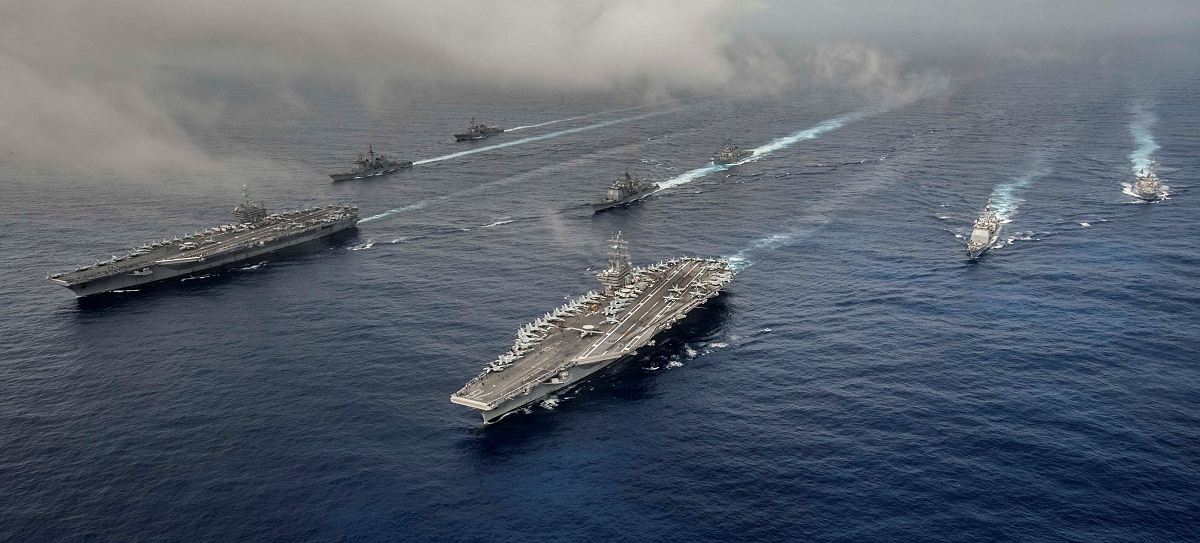DAHLGREN, Va. (Sep. 1, 2016)—The Navy evaluated a strike group's gun weapon systems, combat systems, and unmanned vehicles' interoperability with surface and air assets while firing on targets at the 2016 USS Dahlgren demonstration, Aug. 30.
It was the first time an entire Navy strike group was brought together in a land-based environment spanning the entire kill chain—plan, detect, control, engage and assess.
"This demonstration integrated capabilities across multiple laboratories, utilizing unmanned and manned sensor platforms, engaging a hostile swarm threat of surface craft attacking a virtual naval battlegroup consisting of a Nimitz class aircraft carrier, an Aegis class cruiser and an Independence class Littoral Combat Ship," said Neil Baron, Naval Surface Warfare Center Dahlgren Division (NSWCDD) distinguished scientist for combat control.
At one point, senior Navy officials—flag officers, commanding officers, and two-dozen senior executives—watched engineers fire a 30 millimeter gun on the Potomac River Test Range from their Littoral Combat Ship's (LCS)—Surface Warfare (SUW) Mission Package Command and Control laboratory several miles away.
"This event brings it all together," said Rear Adm. Tom Druggan, NSWC commander. "We have to field systems that are a slam dunk win for the Navy. When push comes to shove, the Navy has to win. Our job is to make sure the fleet wins today and in the future."
The test—made possible by a cybernetic laboratory called USS Dahlgren—conducted engagement coordination with virtual and hardware representations of systems on the USS John C. Stennis (CVN 74), USS Bunker Hill (CG 52), and USS Independence (LCS 2) during live fire destruction of surface threats utilizing the LCS 30 millimeter, Aegis MK 46 gun system's 5-inch guns, and simulated Hellfire missiles.
"This has been five to six years in the making and couldn't come at a better time as we see real-world events such as the recent small boat incursions in the Middle East, highlighting the need for the Fleet," said Capt. Brian Durant, NSWCDD commanding officer.
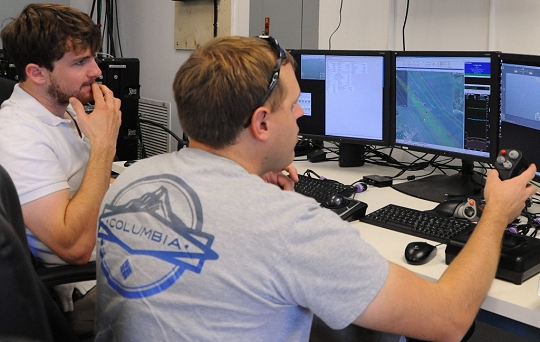 DAHLGREN, Va.—Navy Scan Eagle unmanned aerial vehicle operators Robert Briggs and Scott Heyman conduct launch and recovery efforts via Scan Eagle at the 2016 USS Dahlgren demonstration, Aug. 30. The Scan Eagle was part of the Navy's evaluation of a strike group's gun weapon systems, combat systems, and unmanned vehicles integrated with surface and air assets at the 2016 USS Dahlgren demonstration. The test - made possible by a cybernetic laboratory called USS Dahlgren - proved engagement coordination across the battlegroup and live fire destruction of multiple targets from two combatants utilizing two different gun based systems. (U.S. Navy photo by Patrick Dunn/Released)
DAHLGREN, Va.—Navy Scan Eagle unmanned aerial vehicle operators Robert Briggs and Scott Heyman conduct launch and recovery efforts via Scan Eagle at the 2016 USS Dahlgren demonstration, Aug. 30. The Scan Eagle was part of the Navy's evaluation of a strike group's gun weapon systems, combat systems, and unmanned vehicles integrated with surface and air assets at the 2016 USS Dahlgren demonstration. The test - made possible by a cybernetic laboratory called USS Dahlgren - proved engagement coordination across the battlegroup and live fire destruction of multiple targets from two combatants utilizing two different gun based systems. (U.S. Navy photo by Patrick Dunn/Released)
Druggan, Durant and their counterparts watched as actual combat system equipment from the aircraft carrier and two surface combatant laboratories directed live fire on the Potomac River Test Range as fictitious surface threats attempted to attack.
The live fire engagements continued throughout the scenario, demonstrating integration of currently fielded capabilities—from MH-60R and MH-60S Seahawk helicopters to the Aegis Combat System and the Ship Self-Defense System—with new technologies such as Virtual Automatic Scoring System (VASS).
The NSWCDD-patented VASS calculates gunfire miss distances and adjusts targeting for gunners to converge gunfire onto a target without risking the lives of forward observers.
Live targets were quickly destroyed at safe distances as more than 60 visitors observed the power of integration.
They watched as Naval Air Warfare Center Aircraft Division (NAWCAD) impacted the demonstration with air domain assets and expertise. The NAWCAD Surface Aviation Interoperability Lab 'RoadHawk' tractor trailer with its MH-60R Seahawk surface attack helicopter's avionics suite and a mobile van carrying an MH-60S helicopter provided over-the-horizon threat contact, identification, tracking and simulated Hellfire engagements.
"By utilizing multiple laboratories and live capabilities across the Navy, we are able to model a very realistic, complex battle space environment to thoroughly test our weapon systems" said Amy Markowich, NAWCAD Integrated Battlespace Simulation and Test Department director. "Combining live, virtual and constructive assets such as the Roadhawk, virtualized and hardware-in-the-loop ship simulations, and the LCS 30 millimeter gun here at Dahlgren, make it possible to evaluate how multiple Navy assets will work together easily—and at a much reduced cost."
The event's first scenario featured simulated engagements on maneuvering targets, proving the Navy's ability to use manned and unmanned platforms for early over-the-horizon detection and tracking as well as future unmanned surface vehicle engagements.
USS Dahlgren facilitates this mission with high fidelity testing that leverages both hardware-in-the loop and virtual combat systems.
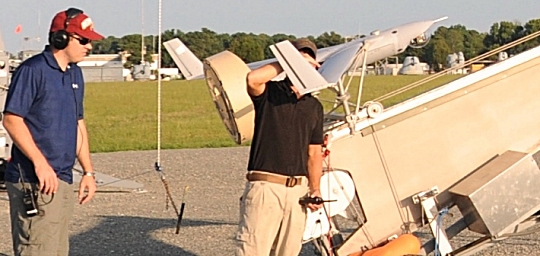 DAHLGREN, Va.—Navy engineers Jonathan Elliott and Richard Lay conduct pre-launch check-outs of a Scan Eagle unmanned aerial vehicle (UAV) at the Naval Surface Warfare Center Dahlgren Division Potomac River Test Range, Aug. 30. The Scan Eagle was crucial to the Navy's evaluation of a strike group's gun weapon systems, combat systems, and unmanned vehicles integrated with surface and air assets at the 2016 USS Dahlgren demonstration.
DAHLGREN, Va.—Navy engineers Jonathan Elliott and Richard Lay conduct pre-launch check-outs of a Scan Eagle unmanned aerial vehicle (UAV) at the Naval Surface Warfare Center Dahlgren Division Potomac River Test Range, Aug. 30. The Scan Eagle was crucial to the Navy's evaluation of a strike group's gun weapon systems, combat systems, and unmanned vehicles integrated with surface and air assets at the 2016 USS Dahlgren demonstration."All testing occurred within the fence in an environment that does not impact Navy ships or crew members," said Steven Shannon, USS Dahlgren tactical operations lead. "The testing normally required aboard a Navy ship and other high demand sites can be now accomplished through USS Dahlgren including capability at other warfare centers."
Its integrated testing capabilities ensure that test and evaluation resources can rapidly adapt to changing warfighters' needs.
In this case, USS Dahlgren created a land-based air and surface representation of a strike group. In the future, the goal is to bring in additional undersea capability through collaboration with other warfare centers.
"The level of complexity shown in this demonstration directly reflects the complexity our operational units see in theaters of operation today," said Melissa Smith, USS Dahlgren lead investigator and Integrated Lab Council lead. "This land-based ability to recreate the complexity of naval surface warfare helps us to find new technologies and repurpose current technologies and equipment. This is the primary mission of our laboratory environment across the nation -maintaining technological advantage for our surface fleet."
USS Dahlgren increases this advantage by providing a mechanism to measure latencies, develop draft concept of operations, and influence systems to improve the entire detect-to-engage kill-chain.
"Early findings and adjustments with respect to the kill-chain are crucial for increased tempo encounters," said Nelson Mills, USS Dahlgren co-lead investigator and capabilities development lead. "The short-term goal for USS Dahlgren is to leverage and connect to existing Naval infrastructure at NR&DE (Naval Research and Development Establishment) sites and to virtualize any missing elements as necessary, creating an air, surface, undersea test bed that replicates our current and future strike groups."
In a 2014 test, the USS Dahlgren—a Navy Innovative Science and Engineering funded-test bed—proved it could integrate unmanned vehicles into the fire control loop of a major weapon system aboard a surface combatant.
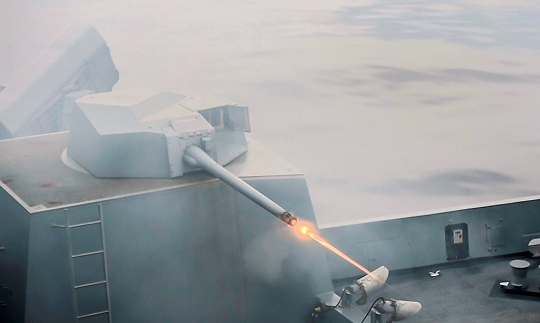 EAST CHINA SEA—The amphibious transport dock ship USS Green Bay (LPD 20) fires a MK-46 30mm gun during a live-fire exercise. Navy scientists and engineers evaluated a strike group's Aegis combat system and gun weapon systems - including the 30 millimeter gun - as well as unmanned vehicles integrated with surface and air assets at the 2016 USS Dahlgren demonstration, Aug. 30. The test - made possible by a cybernetic laboratory called USS Dahlgren - proved engagement coordination across the simulated battlegroup and live fire destruction of multiple targets from two combatants utilizing two different gun based systems. "This has been five to six years in the making and couldn't come at a better time as we see real-world events such as the recent small boat incursions in the Middle East, highlighting the need for the Fleet," said Capt. Brian Durant, NSWCDD commanding officer. (U.S. Navy photo by Mass Communication Specialist 3rd Class Patrick Dionne/Released)
EAST CHINA SEA—The amphibious transport dock ship USS Green Bay (LPD 20) fires a MK-46 30mm gun during a live-fire exercise. Navy scientists and engineers evaluated a strike group's Aegis combat system and gun weapon systems - including the 30 millimeter gun - as well as unmanned vehicles integrated with surface and air assets at the 2016 USS Dahlgren demonstration, Aug. 30. The test - made possible by a cybernetic laboratory called USS Dahlgren - proved engagement coordination across the simulated battlegroup and live fire destruction of multiple targets from two combatants utilizing two different gun based systems. "This has been five to six years in the making and couldn't come at a better time as we see real-world events such as the recent small boat incursions in the Middle East, highlighting the need for the Fleet," said Capt. Brian Durant, NSWCDD commanding officer. (U.S. Navy photo by Mass Communication Specialist 3rd Class Patrick Dionne/Released)"Efforts, like what we saw today, allow the Navy to explore new technologies and rapidly evaluate and deploy new capabilities to the Fleet. The USS Dahlgren modeling and simulation work is leading the way for the Naval Research and Development Establishment," said Markowich, the Department of the Navy Modeling and Simulation executive for the Assistant Secretary of the Navy (Research, Development and Acquisition).
Meanwhile, NSWCDD plans to leverage USS Dahlgren to support integration of electromagnetic railgun solid-state lasers, and other initiatives for risk mitigation prior to fielding.
"This year we are taking the next big step for USS Dahlgren by integrating the fire control loop in an ever increasing complex operational scenario," said Baron.
The fire control loop's compatibility with complex systems and missions is now a fact due to USS Dahlgren's highly integrated lab environment that can emulate a kill chain, ship, or battle group while serving as a rapid prototyping and experimentation platform.
This integration is made possible by Navy-wide infrastructure linked to USS Dahlgren, including experimental test ranges, waterfront, and airspace; tactical and developmental command and control laboratories, sensors, weapons, manned and unmanned platforms; hardware in the loop and virtualized combat systems; and external connectivity via Department of Defense networks and over-the-air connectivity.
"In effect, USS Dahlgren provides a naval venue for research, development, test and evaluation that spans all aspects of the kill chain," said Mills. "It provides for continuous testing across the acquisition lifecycle in a high fidelity environment via distributed network architectures."
This constant testing capability spans the acquisition lifecycle, featuring off-site connectivity to investigate ship, battle force, and joint force integration and the ability to replicate the fleet environment to address issues observed at sea.
"These couldn't be more exciting times for the naval scientist and engineer," said Baron. "Designing and delivering new equipment is very important. We also have tremendous intellectual talent across the Naval Research and Development Establishment to draw latent capabilities out of the equipment we already have by integrating things in new ways and enabling warfighting capabilities that only a Navy battle group can deliver."
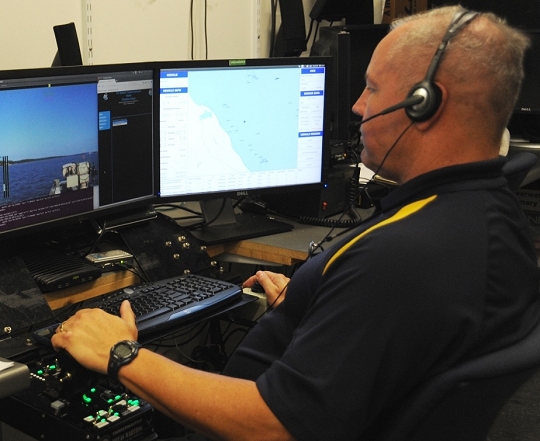 DAHLGREN, Va.—Eugene Rivers, a Navy unmanned surface vessel (USV) operator, conducts over-the-horizon contact detection and tracking in addition to battle damage assessment following engagement at the 2016 USS Dahlgren demonstration, Aug. 30. The USV was part of the Navy's evaluation of a strike group's gun weapon systems, combat systems, and unmanned vehicles integrated with surface and air assets. The virtual USS Dahlgren proved engagement coordination across the battlegroup and live fire destruction of multiple targets from two combatants utilizing two different gun based systems. (U.S. Navy photo by George Smith/Released)
DAHLGREN, Va.—Eugene Rivers, a Navy unmanned surface vessel (USV) operator, conducts over-the-horizon contact detection and tracking in addition to battle damage assessment following engagement at the 2016 USS Dahlgren demonstration, Aug. 30. The USV was part of the Navy's evaluation of a strike group's gun weapon systems, combat systems, and unmanned vehicles integrated with surface and air assets. The virtual USS Dahlgren proved engagement coordination across the battlegroup and live fire destruction of multiple targets from two combatants utilizing two different gun based systems. (U.S. Navy photo by George Smith/Released)